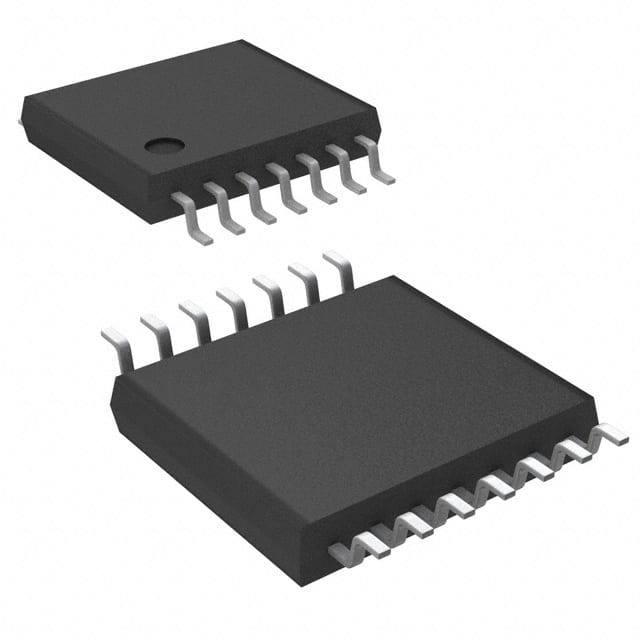AD5251BRU10-RL7
Product Overview
Category
The AD5251BRU10-RL7 belongs to the category of digital potentiometers.
Use
It is primarily used for electronic circuitry and control systems where variable resistance is required.
Characteristics
- Digital control interface
- Non-volatile memory
- Low power consumption
- Wide operating voltage range
- High resolution
Package
The AD5251BRU10-RL7 comes in a small outline integrated circuit (SOIC) package.
Essence
This product serves as a replacement for traditional mechanical potentiometers, offering greater precision and flexibility in electronic circuits.
Packaging/Quantity
The AD5251BRU10-RL7 is typically packaged in reels and is available in quantities of 2500 units per reel.
Specifications
- Resolution: 256 steps
- Resistance Range: 10 kΩ
- Operating Voltage: 2.7 V to 5.5 V
- Temperature Range: -40°C to +125°C
- Interface: I2C-compatible
Detailed Pin Configuration
The AD5251BRU10-RL7 has a total of 14 pins, which are configured as follows:
- VDD: Power supply voltage
- SDA: Serial data input/output
- SCL: Serial clock input
- A0: Address bit 0
- A1: Address bit 1
- WP: Write protect
- VSS: Ground
- RDAC: Resistor terminal A
- RDAC: Resistor terminal B
- RH: Terminal H
- RL: Terminal L
- VLOGIC: Logic supply voltage
- NC: No connection
- NC: No connection
Functional Features
- Digital control allows for precise adjustment of resistance.
- Non-volatile memory retains settings even when power is disconnected.
- Low power consumption makes it suitable for battery-powered applications.
- Wide operating voltage range enables compatibility with various systems.
- High resolution provides fine-grained control over resistance.
Advantages and Disadvantages
Advantages
- Greater precision compared to mechanical potentiometers.
- Flexible and programmable resistance adjustment.
- Compact size and easy integration into electronic circuits.
- Non-volatile memory ensures settings are retained.
Disadvantages
- Limited resistance range compared to some other digital potentiometers.
- Relatively higher cost compared to mechanical alternatives.
- Sensitivity to electrostatic discharge (ESD) requires careful handling during installation.
Working Principles
The AD5251BRU10-RL7 utilizes a combination of digital control and integrated resistive elements to achieve variable resistance. The digital control interface, such as I2C, allows for precise adjustment of the resistance value. The non-volatile memory ensures that the resistance setting is retained even when power is disconnected. The integrated resistive elements provide the desired resistance range and accuracy.
Detailed Application Field Plans
The AD5251BRU10-RL7 finds applications in various fields, including:
- Audio Equipment: Volume control, tone adjustment, and equalization circuits.
- Industrial Automation: Variable resistance for motor speed control, light dimming, and process control.
- Test and Measurement Instruments: Calibration and signal conditioning circuits.
- Automotive Electronics: Climate control, dashboard controls, and audio systems.
- Medical Devices: Precision control in diagnostic equipment and therapy devices.
Detailed and Complete Alternative Models
- AD5241BRUZ10-RL7: 10 kΩ digital potentiometer with similar specifications.
- AD5260BRUZ10-RL7: 10 kΩ digital potentiometer with higher resolution and extended temperature range.
- AD8400ARZ10-RL7: 10 kΩ digital potentiometer with parallel interface and lower cost.
These alternative models offer similar functionality and can be considered based on specific application requirements.
Word count: 560 words
قم بإدراج 10 أسئلة وإجابات شائعة تتعلق بتطبيق AD5251BRU10-RL7 في الحلول التقنية
Sure! Here are 10 common questions and answers related to the application of AD5251BRU10-RL7 in technical solutions:
Q1: What is the AD5251BRU10-RL7? A1: The AD5251BRU10-RL7 is a digital potentiometer IC (integrated circuit) manufactured by Analog Devices. It is designed to provide variable resistance in electronic circuits.
Q2: What is the maximum resistance range of the AD5251BRU10-RL7? A2: The AD5251BRU10-RL7 has a maximum resistance range of 10 kilohms (kΩ).
Q3: How is the AD5251BRU10-RL7 controlled? A3: The AD5251BRU10-RL7 can be controlled using an I2C (Inter-Integrated Circuit) interface, allowing for digital control of the resistance value.
Q4: Can the AD5251BRU10-RL7 be used as a volume control in audio applications? A4: Yes, the AD5251BRU10-RL7 can be used as a volume control in audio applications, providing precise and adjustable resistance for volume adjustment.
Q5: Is the AD5251BRU10-RL7 suitable for use in low-power applications? A5: Yes, the AD5251BRU10-RL7 is designed for low-power operation, making it suitable for battery-powered devices or other low-power applications.
Q6: Can multiple AD5251BRU10-RL7 ICs be connected together for increased resistance range? A6: Yes, multiple AD5251BRU10-RL7 ICs can be connected together in series to increase the overall resistance range.
Q7: Does the AD5251BRU10-RL7 have non-volatile memory? A7: Yes, the AD5251BRU10-RL7 has non-volatile memory, allowing it to retain its resistance value even when power is removed.
Q8: What is the resolution of the AD5251BRU10-RL7? A8: The AD5251BRU10-RL7 has a resolution of 256 steps, providing fine-grained control over the resistance value.
Q9: Can the AD5251BRU10-RL7 be used in industrial automation applications? A9: Yes, the AD5251BRU10-RL7 can be used in industrial automation applications where precise resistance control is required.
Q10: Is the AD5251BRU10-RL7 available in a surface-mount package? A10: Yes, the AD5251BRU10-RL7 is available in a small and compact surface-mount package, making it suitable for space-constrained designs.
Please note that these answers are general and may vary depending on specific application requirements.


